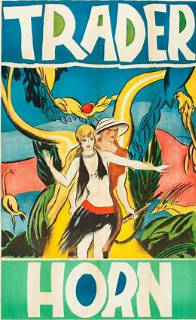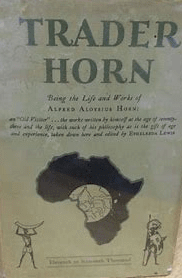Balladeer’s Blog continues reviewing the 1927 book Trader Horn, the quasi-autobiographical account of the British Trade Agent Alfred Aloysius Horn’s adventures in Africa during the late 1800s. For Part One click HERE.
 PART FIVE – Horn recounted an incredible event he attended in Angola, which was not yet the name of the country, just a populated region. He and his subordinate Trade Agents were guests at a conjo – a performance of traveling entertainers called the Akowas.
PART FIVE – Horn recounted an incredible event he attended in Angola, which was not yet the name of the country, just a populated region. He and his subordinate Trade Agents were guests at a conjo – a performance of traveling entertainers called the Akowas.
Alfred praised the precision routines of the acrobats, sword-dancers, trick shooters and their colleagues. The Akowas displayed excellent stagecraft and made Horn and his men gasp in awe as the performers pretended to shoot each other through with arrows, complete with seeming penetration, only for the finale to present all of them getting up just fine for the audience to see.
The next day, Trader Horn and his aides were making contracts with the tribe for the trade in wood, large canoes, dried fish and farina. One of Alfred’s indigenous employees was a son of a Camma chief and engaged him in further conversation about the Izoga – the Holy Person hidden from common view several villages back.
The aide, Renchoro, confirmed for Horn that the Izoga in that particular village was a white woman, the surviving child of the long dead Englishman, called only “the Honorable George T_____” throughout the book. Her name was Nina.
 NOTE: The movies based on this book center on the alleged white blonde woman from a well-known British family which Horn conveniently refused to name. Though readers might have suspected H. Rider Haggard’s works to lie behind the “blonde jungle goddess” trope that infected countless jungle adventures, it seems that Trader Horn and its film adaptations were really responsible.
NOTE: The movies based on this book center on the alleged white blonde woman from a well-known British family which Horn conveniently refused to name. Though readers might have suspected H. Rider Haggard’s works to lie behind the “blonde jungle goddess” trope that infected countless jungle adventures, it seems that Trader Horn and its film adaptations were really responsible.
Nina’s oldest brother had signed on with a ship’s crew long ago, and the other two boys had died since then, leaving only the mother and Nina. The mother married one of the indigenous physicians and, along with little Nina, spent the rest of her life with that tribe.
I have no idea how likely or how acceptable such a mixed-race marriage would have been to the native population in 1870s and 1880s Africa, let alone the white daughter growing to the revered role of village Izoga. I’ve often pointed out that Trade Agent Horn’s tales strike me as being embellished as much as Wyatt Earp’s or Buffalo Bill Cody’s. That’s why I call them “quasi-autobiographical” instead of semi-autobiographical.
Carrying through on this tale of the Izoga, Horn related his initiation into the Ivili “Mystery Cult.” Having earned enough trust over the years, Alfred was vouched for by the chief and was ordered to follow the chief’s every move in the tall temple building.
The equivalent of incense was heavy in the air inside the temple, which had a Skull House formation of head bones along both sides of the entrance. Chants which Horn could not understand were recited as the ritual played out.
 Amid masks, laying hands on sacred objects and many incantations, Trader Horn was initiated. Upon completion of the ritual he was permitted to look upon the sacred Izoga herself, who had entered during the ceremony.
Amid masks, laying hands on sacred objects and many incantations, Trader Horn was initiated. Upon completion of the ritual he was permitted to look upon the sacred Izoga herself, who had entered during the ceremony.
She was masked upon entering, but upon Alfred being welcomed into the society, she removed her mask. Horn claimed she was, in fact, a blonde white woman, whose age our man estimated as sixteen. While she appraised him in silence, music from ngombi harps was played.
At length the blonde teen sang a song in the native language, with the chief and other tribesmen adding their parts here and there. When that was concluded, Horn was permitted to bow to the girl and leave the temple.
A meal with the chief came next, and the man informed Trader Horn of all his obligations and privileges as a member. Among them, he must always come to the aid of his coreligionists (as Alfred called them) as they must always come to his.
Horn and his expedition then moved on, and once back closer to the coast, his aide Renchoro showed him once again the grave of the Honorable George T_______. While there, the leader of the native Africans who had once worked for George showed him a strongbox that used to belong to the late George T.
 Inside were photos of the man’s wife and children, including the little girl that Trader Horn now presumed to be the Izoga of the Ivilis. George’s journal was inside and revealed that he had educated Nina in reading and writing before his passing.
Inside were photos of the man’s wife and children, including the little girl that Trader Horn now presumed to be the Izoga of the Ivilis. George’s journal was inside and revealed that he had educated Nina in reading and writing before his passing.
In the months ahead, Alfred claims he grew comfortable enough to slip a note in English to “Nina” during one of the cult’s ceremonies. She understood it, he claimed, opening up a means of communication between them.
THINGS START TO REALLY PICK UP NEXT TIME AROUND.

Great posts as always. I am not familiar with the stories of Trader Horn, but they do appear to be fascinating to me. The adventurer’s stories bring back memories of movies I admire. For instance, Trader Horn’s stories remind me of the Marvel film “Black Panther”. It tells the story about an African kingdom of Wakanda which is similar to the tribe that Trader Horn encounters. One of the greatest comic book movies ever made. Here is why it’s worth watching:
That’s very nice of you, thanks!
I probably would have read this back in the day. Definitely a step above the dime novels.
I know what you mean!
Pingback: TRADER HORN (1927): PART FIVE – El Noticiero de Alvarez Galloso
Logged, thank you sir!
Pingback: TRADER HORN (1927): PART FIVE – ATiA
Logged, thank you!
https://x.com/madameatia/status/1803482576625287584
Thank you very much!
You’re welcome ☺️
😀